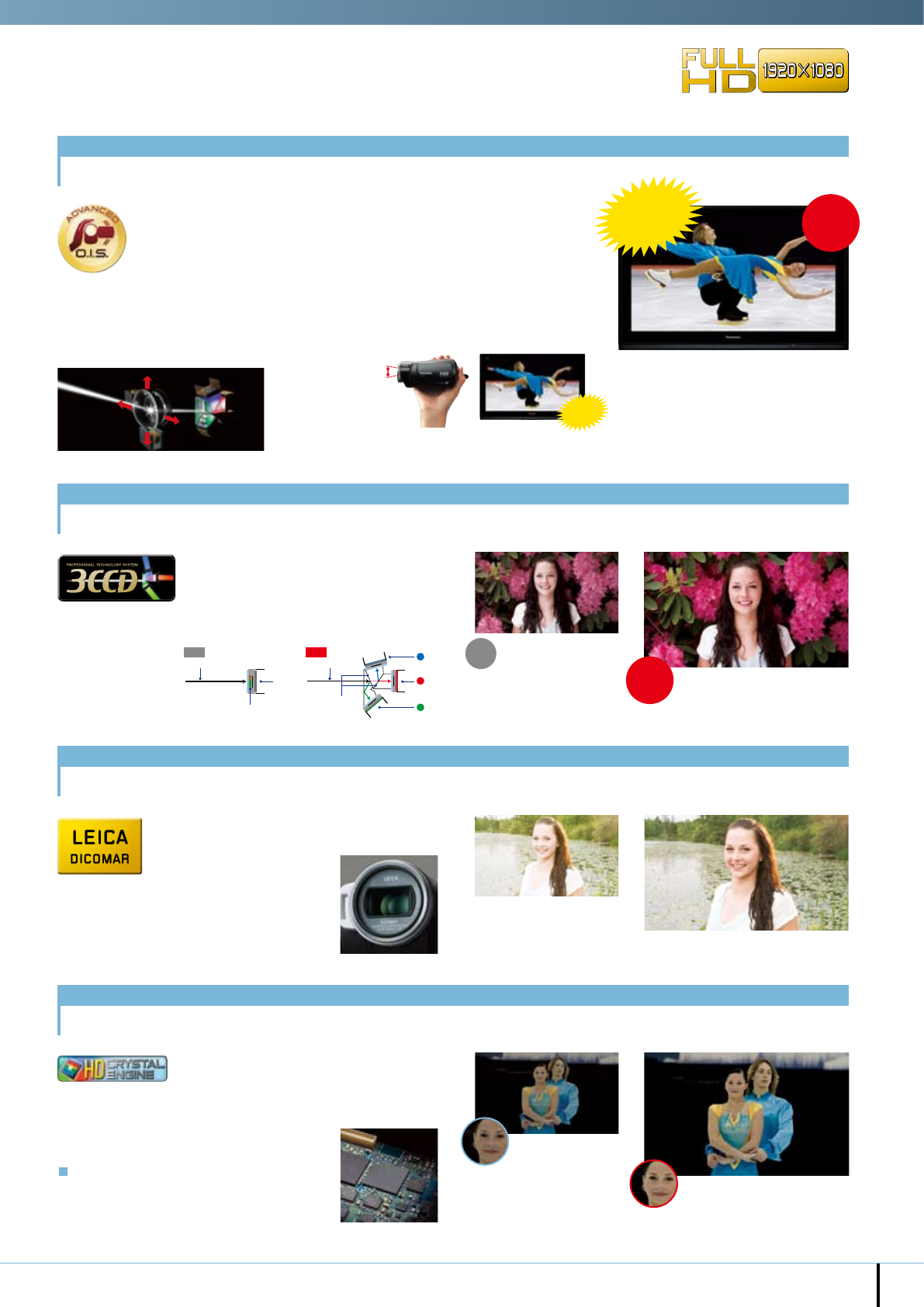
5
Precise hand-shake compensation: Prevents blurry images caused by unsteady hands as you shoot
Advanced O.I.S. (Optical Image Stabiliser)
50" Display (O.I.S. OFF)
O.I.S. Lens
The lens moves up/
down or left/right and
bends the incoming
light to correct hand-
shake.
Moving the camcorder even a tiny bit results in some
blurring – which is especially noticeable on a large screen.
Clear!
The hand-shake correction frequency has been increased
from 500 to 4,000 times per second!
Most professional broadcasting cameras use the
3CCD camera system, due to its superior colour
reproduction. In a 1CCD system, all of the incoming
light information is processed by the same CCD. The more advanced 3CCD
system uses three distinct CCDs for processing, so there is absolutely no light
loss. The 3CCD camera
system draws out the
full potential of full-HD
image quality.
3CCD Camera System
Superb colour reproduction – faithful, natural colours with delicate nuances
The woman's skin and flowers
don't look natural, they look
artificial.
3CCD
The woman's skin and flowers have
natural colour and look real.
1CCD
3CCD
1CCD
CCD
Optical Axis
Colour Filter
CCD
Optical Axis
Dichroic
Mirrors
G
CCD
R
CCD
B
The SD5 and SX5 boast a Leica Dicomar lens. Developed
specifically for full-HD digital camcorders, this lens system is
made using a multi-coating process
that minimises light reflection and
glare, which can make colours bleed and images appear
washed out. It also minimises rings of light, or "ghosts."
*Leica is a registered trademark of Leica Microsystem IR GmbH,
and Dicomar is a registered trademark of Leica Camera AG.
Leica Dicomar Lens
A superb optical system that captures even delicate, subtle nuances
Washed-out image due to strong light
Multi-coated lens:
clear image with no colour bleeding
High-speed processing: An imaging engine that handles the vast amount of data in full-HD images
HD Crystal Engine
With HD Crystal Engine:
smooth from corner to corner
Without HD Crystal Engine:
picture noise
Panasonic took the advanced imaging circuitry used in our
professional equipment and adapted it for home use in the HD
Crystal Engine. The result is a high-speed processing unit that can handle the huge volumes
of data captured in high-definition video recordings. The HD Crystal Engine also incorporates
a new system that improves resolution and reduces noise while
achieving a more compact size and lowering power consumption.
Video Compression LSI
Designed specifically for full-HD recording, this advanced LSI provides the
high compression (H.264 High Profile used) needed to achieve high-resolution
recording with a low bit rate. It helps ensure beautiful recordings by minimising
the image degradation that can occur when shooting fast-moving subjects.
Blurry!
HD Crystal Engine
Advanced
O.I.S.
ON
Panasonic's Advanced O.I.S. is a new image stabilising function that achieves around
eight times higher precision than our previous system. The system uses gyro-sensors
to detect hand-shake, then shifts a lens and adjusts its optical axis to compensate. And
while our previous system checked and compensated for hand-shake around 500 times
per second, the new Advanced O.I.S. works around 4,000 times per second. Advanced O.I.S. enables
finer, more effective hand-shake compensation. Also, because the system is optical, no image quality is
lost. With Advanced O.I.S., you'll capture images that are clear, sharp and beautiful on a big TV screen.
The skaters' expressions and
costumes are crisp and razor-sharp.
Even on a big screen, the images are
virtually blur-free.














